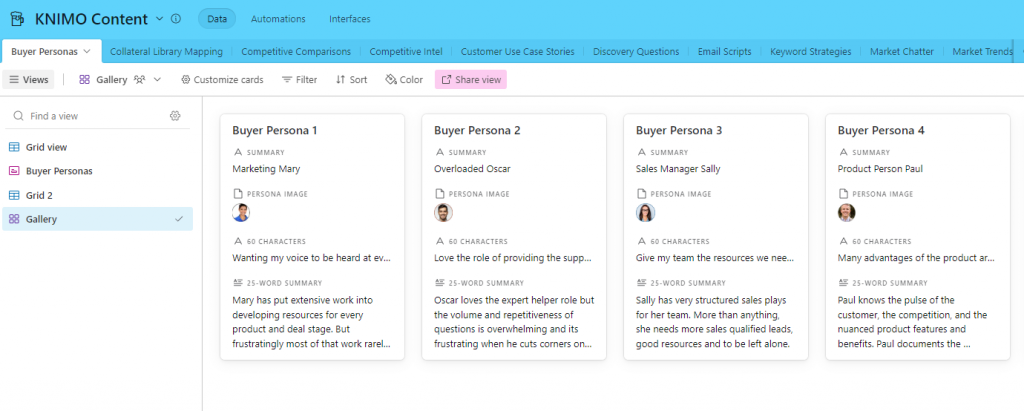With several months of experimenting now behind us, the team at PMPathlights (Product Marketing Pathlights) thought it might be useful to share a small number of our observations about using ChatGPT Generative AI for product marketing purposes.
First, a bit of context. The PMPathlights team is composed of both creators and consumers of product marketing content. From these backgrounds, we strive to preempt the historic gaps between what product marketers create and what revenue and customer support teams desire to use, gaps that often lead to lack of use. To address this age old challenge, we developed our product marketing framework with a focus on:
- Creating in depth content in concise buckets that are easy to find and use
- Designing content to match the communication channels often used including the ability for the customer/revenue-facing teams of an organization to simply copy and paste the nuggets they need.
- Providing an easy to populate and maintain product marketing taxonomy so that content is easy to keep current and be dynamically assembled into customer and/or internally facing content.
Additionally, the desire was also to store content in a highly relational way so that updates are universally applied and out-dated information removed. To that end, we built our PMPathlights framework which you can get a glimpse of in the screenshots below.


Much of our work with ChatGPT has centered around supporting the population of this framework, which is quite detailed in some categories. Here are seven key things – among many – that we’ve learned:
- A framework helps tremendously
We tried both random prompting for random product marketing content creation objectives and found, well, randomness. The content wasn’t wrong, per se, but not as useful as when we focused our prompting on specific content we wanted for the PMPathlights framework. - Use existing content as your target
We learned quickly to have very specific outcomes in mind as we set up our prompt schemas. As an example, if you have an existing formula you use for product sheets or competitor battle cards, select an example piece of content and use it to build your prompt question schema (content and sequence). - Build a repeatable prompt schema
Using a schema is essential for getting consistent responses and value from ChatGPT. There will be a bit of trial and error as you build your schema and you will have to restart a session each time you make a shift so that the sequence (see below) of prompt questions stay consistent. However, once your model is done, you can rapidly apply it to all relevant items (for example, build a schema to complete one competitor profile and then apply it to create additional competitor profiles). - Experiment with the order of your prompt questions
One of our early discoveries was how critical the order of prompt questions was to the outcomes we got back. There is no magical sequence (at least we haven’t found it yet) that can be applied to every type of content creation. - Learn when to direct ChatGPT to content it needs
When content is recent or a company or product is not well known, append your schema to include instructions on where to find content, for example, drawing on content from www.pmpathlights.com, list seven observations on using ChatGPT for product marketing. - Be overly specific in your ask / Test how you prompt
Because the PMPathlights methodology is highly structured and very focused on concise content, we have learned to be highly structured and instructive in our prompt questions. For example, in our schema we have a question to determine top objections one might expect to hear in a sales process. We then ask for three responses with supporting quotes from customers from third-party websites. Further, we instruct the maximum number of words to use and if we want bullet points, outlines, or free-form paragraphs. - Finish with a human
ChatGPT can be very useful in efficiently creating volumes of baseline product marketing content but it won’t always be complete or accurate. Like the humans it attempts to replicate, in the absence of specific knowledge it is quick to create generic content or, in some cases, create hypothetical answers. Human subject matter experts will still be needed. Compile these SME insights in a place you can send ChatGPT to for its guidance. We believe Assistive Intelligence Technology is a far better description than artificial intelligence, at least at this point.
How we are applying ChatGPT to our Framework / How to join us
While the team at PMPathlights would emphasize that we are very early in our journey, we have developed an initial prompt schema for populating the PMPathlights Product Marketing framework that has worked well as we have applied it to multiple organizations. If you’d like to join us in that journey, reach out to one of us. We would welcome a chance to run a high level test for you in exchange for your feedback on how well our prompt question schema (and ChatGPT) performed.